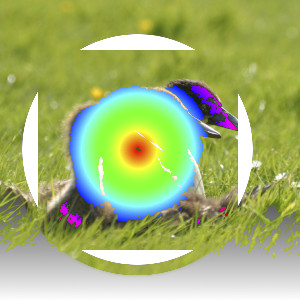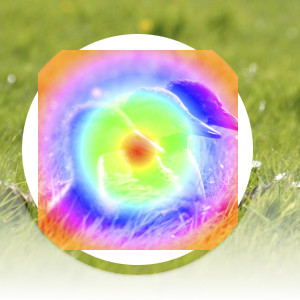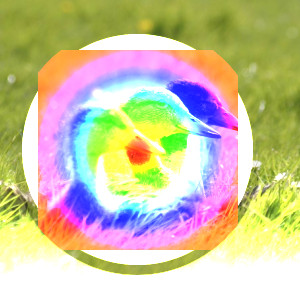| 2.2. Καταστάσεις στρώσεων φωτισμού | ||
|---|---|---|

|
2. Καταστάσεις στρώσεων |  |
Η ομάδα «Φωτισμός» περιέχει καταστάσεις στρώσεων που κάνουν το αποτέλεσμα πιο ανοιχτόχρωμο.
Σχήμα 8.15. Παράδειγμα για κατάσταση στρώσης «Φωτισμός μόνο»

Η επάνω στρώμα με 100% αδιαφάνεια χρησιμοποιώντας την κατάσταση «Μόνο φωτισμός».
Η κατάσταση συγκρίνει κάθε συστατικό καθενός εικονοστοιχείου στην κορυφαία στρώση με το αντίστοιχο στην χαμηλότερη στρώση και χρησιμοποιεί την μεγαλύτερη τιμή στην τελική εικόνα. Πλήρως μαύρες στρώσεις δεν επιδρούν στην τελική εικόνα και πλήρως λευκές στρώσεις καταλήγουν σε λευκή εικόνα.
Η κατάσταση είναι αθροιστική· η σειρά των δύο στρώσεων δεν πειράζει, (εκτός από διαφανείς περιοχές στην κάτω στρώση).
Σχήμα 8.16. Παράδειγμα για την κατάσταση στρώσης «Μόνο άνοιγμα ασπρόμαυρης φωτεινότητας/λαμπρότητας (Luma/Luminance)»

Η κορυφαία στρώση με 100% αδιαφάνεια χρησιμοποιώντας την κατάσταση «Μόνο άνοιγμα Ασπρόμαυρη φωτεινότητα/Λαμπρότητα (Luma/Luminance)».
Η κατάσταση συγκρίνει τη λαμπρότητα κάθε εικονοστοιχείου στην κορυφαία στρώση με την αντίστοιχη στην χαμηλότερη στρώση και χρησιμοποιεί την μεγαλύτερη τιμή στην τελική εικόνα. Πλήρως μαύρες στρώσεις δεν επιδρούν στην τελική εικόνα και πλήρως λευκές στρώσεις καταλήγουν σε λευκή εικόνα. Ασπρόμαυρη φωτεινότητα (Luma) είναι η διαισθητική έκδοση της λαμπρότητας.
Η κατάσταση είναι αθροιστική· η σειρά των δύο στρώσεων δεν πειράζει, (εκτός από διαφανείς περιοχές στην κάτω στρώση).
Σχήμα 8.17. Παράδειγμα για την κατάσταση στρώσης «Οθόνη»

Η επάνω στρώση με αδιαφάνεια 100% χρησιμοποιώντας την κατάσταση «Οθόνη».
Η κατάσταση Οθόνη μετατρέπει τις τιμές καθενός από τα ορατά εικονοστοιχεία στις δύο στρώσεις της εικόνας. (Δηλαδή, αφαιρεί καθένα τους από το 1,0.) Έπειτα τις πολλαπλασιάζει μαζί, και αντιστρέφει πάλι αυτήν την τιμή. Η τελική εικόνα είναι συνήθως πιο φωτεινή και μερικές φορές «ξεπλυμένη» στην εμφάνιση. Οι εξαιρέσεις σ' αυτό είναι μια μαύρη στρώση που δεν αλλάζει την άλλη στρώση και η λευκή στρώση που καταλήγει σε άσπρη εικόνα. Πιο σκούρα χρώματα στην εικόνα φαίνονται να είναι πιο διαφανή.
Η κατάσταση είναι αθροιστική· η σειρά των δύο στρώσεων δεν πειράζει.
Σχήμα 8.18. Παράδειγμα για κατάσταση στρώσης «Υπεκφυγή»

Η επάνω στρώση με 100% αδιαφάνεια χρησιμοποιώντας τη λειτουργία «Ξάνοιγμα».
Η κατάσταση Ξάνοιγμα διαιρεί την τιμή του εικονοστοιχείου της κατώτερης στρώσης με το αντίστροφη της τιμής του εικονοστοιχείου της επάνω στρώσης. Η τελική εικόνα είναι συνήθως πιο φωτεινή, αλλά μερικά χρώματα μπορεί να αντιστραφούν.
Στη φωτογραφία υπεκφυγή είναι μια τεχνική που χρησιμοποιείται σε ένα σκοτεινό δωμάτιο για να μειώσει την έκθεση σε συγκεκριμένες περιοχές της εικόνας. Αυτό προσφέρει λεπτομέρειες στις σκιές. Όταν χρησιμοποιείται για αυτό το σκοπό η υπεκφυγή δουλεύει άριστα σε εικόνες γκρι κλίμακας και καλύτερα με ένα εργαλείο ζωγραφικής παρά με κατάσταση στρώσης.
Σχήμα 8.19. Παράδειγμα για κατάσταση στρώσης «Προσθήκη»

Η επάνω στρώση με 100% αδιαφάνεια χρησιμοποιώντας την κατάσταση «Πρόσθεση».
Η κατάσταση Πρόσθεση είναι πολύ απλή. Οι τιμές εικονοστοιχείου της κορυφαίας και της κατώτερης στρώσης προστίθενται μεταξύ τους. Η τελική εικόνα είναι συνήθως πιο φωτεινή. Η εξίσωση μπορεί να καταλήξει σε χρωματικές τιμές μεγαλύτερες από 1,0.
Η κατάσταση είναι αθροιστική· η σειρά των δύο στρώσεων δεν πειράζει.